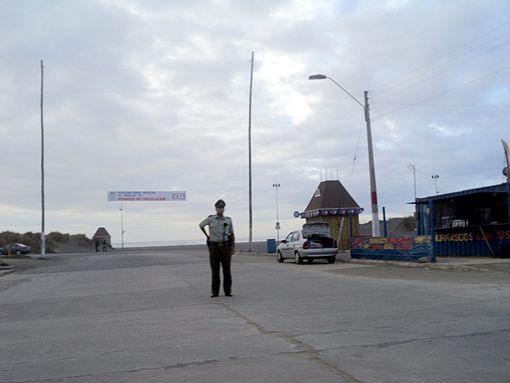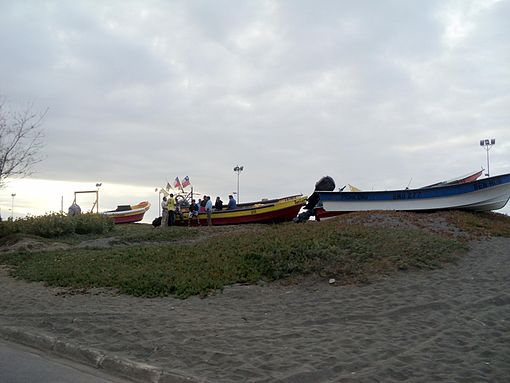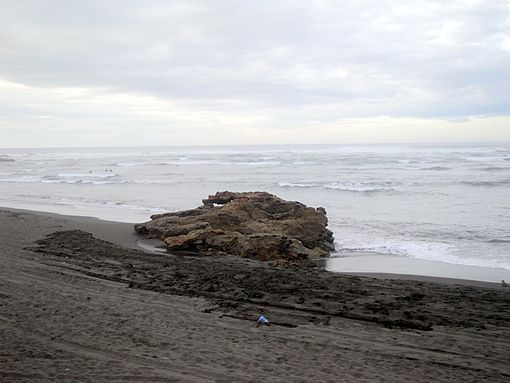Special report on Japanese tsunami emergency in Pichilemu, Chile
Saturday, March 12, 2011

Image: Diego Grez.
On Friday, a strong earthquake in Japan triggered a massive tsunami throughout the Pacific Ocean. Chilean President Sebastián Piñera declared a "preventive tsunami warning" that morning. "I want to express my, and Chilean people's solidarity with the Japanese government and people, who were hit by one of the worse earthquakes and tsunamis in the history of mankind," Piñera said. Later that day, the tsunami first reached Chilean territory in Easter Island, without causing any damage.
Meanwhile, in Pichilemu, O'Higgins Region, the tsunami warning caused panic amid people. "It reminds me of 4 October 1994 [after an earthquake in Russia provoked a tsunami throughout the Pacific], when we had to leave everything and either go to the hill or Santa Cruz," ((es))Spanish language: Me recuerda del 4 de octubre de 1994, cuando tuvimos que dejarlo todo e ir ya sea al cerro o a Santa Cruz. a fisherman told Wikinews.
Schools executed the Francisca Cooper Integral Evacuation and School Safety Plan, a preventive emergency operation against earthquakes, fires, and other emergencies, during Friday morning. The operation, officially called "Cooper Plan", is named after Francisca Cooper, killed in Indonesia after the 2004 tsunami.
During the afternoon, people living or owning stores, restaurants, and kiosks near the beach began to take their belongings away, due to the potential damage the tsunami would cause. Police officers did not allow cars to pass by the nearest street to the beach, the Costanera Avenue, especially in the Cardenal Caro Province Government area; however, curious people traveling on foot were able to see the strong waves hitting the Pichilemu shoreline before the eventual tsunami. The Agustín Ross Balcony was used mostly for that purpose, until Investigations Police of Chile (Chilean equivalent to the United States' Federal Bureau of Investigation) told people to leave the area because "it was dangerous."
At around 16:30 local time (19:30 UTC), the Intendant of O'Higgins Region, Rodrigo Pérez Mackenna, arrived at Pichilemu Municipal Stadium in a helicopter, to inform Mayor Roberto Córdova of what he and other authorities should do because of the emergency, according to reports.
Fishermen took their boats away from the beach. "I don't want to lose it [the boat] again, we were already very affected by the February 27 earthquake and I just don't want that to happen again; we still have time," a fisherman, Manuel González said.
At around 21:30 local time (00:30 UTC), heavy rain began to fall in the city. Most of the people who evacuated to the La Cruz Hill quickly went back to their houses, despite most of them being too close to the beach to be safe. Some of them preferred to stay in refuges provided by the municipality of Pichilemu: the Pichilemu Municipal Gymnasium, and the Pueblo de Viudas Primary School. Fabricio Cáceres said on Canal 3 Pichilemu that "people should stay calm," and that the tsunami "would not be any worse than February 27's." Personnel of the Pichilemu Police, the Pichilemu Fire Bureau, and Investigations Police of Chile kept on patrolling the city's streets.
The Pichilemu Hospital, located around 100 meters from the beach, was moved temporarily to the Agustín Ross Edwards High School facilities.
The tsunami waves finally hit Pichilemu at around 03:30 local time (06:30 UTC) on Saturday, damaging some kiosks that were too close to the beach. In Playa Hermosa, around three kilometers south of the center of the city, the tsunami even reached houses and cabañas, but caused no damage. Some reports on Radio Entre Olas say that the tsunami reached up to 70 meters inland. According to Hernán de Solminihac, Minister of Public Works, Pichilemu's Caleta de Pescadores (Fishermen Creek, almost completely destroyed on February 27, 2010 after that day's earthquake) suffered minor damage.
The tsunami warning was lifted in most of Chilean territory but "Arica, Iquique, Antofagüasta [sic], Caldera, Constitución, Talcahuano, and Lebu," by Sebastián Piñera at 10:45 local time (13:45 UTC) on Saturday.
Governor of Cardenal Caro Julio Ibarra said that "around 10,000 people were evacuated in Pichilemu to Pueblo de Viudas or La Cruz Hill," and that the tsunami was "just meters away from affecting the [Cardenal Caro] province government building."

Image: Diego Grez.
Image: Diego Grez.

Image: Diego Grez.
Image: Diego Grez.

Image: Diego Grez.
Image: Diego Grez.

Image: Diego Grez.
Image: Diego Grez.

Image: Diego Grez.
Image: Diego Grez.

Image: Diego Grez.
Image: Diego Grez.

Image: Diego Grez.
Image: Diego Grez.

Image: Diego Grez.
Image: Diego Grez.

Image: Diego Grez.
Image: Diego Grez.

Image: Diego Grez.
Image: Diego Grez.

Image: Diego Grez.
Image: Diego Grez.

Image: Diego Grez.
Image: Diego Grez.

Image: Diego Grez.
Image: Diego Grez.

Image: Diego Grez.
Image: Diego Grez.

Image: Diego Grez.
Image: Diego Grez.

Image: Diego Grez.
Image: Diego Grez.

Image: Diego Grez.
Image: Diego Grez.

Image: Diego Grez.
Image: Diego Grez.

Image: Diego Grez.
Image: Diego Grez.
Sources
- Some information contained in this article was obtained from television or radio sources, or via a live webcast. Reporter's notes and the broadcast/webcast source details are available on the discussion page.
- "Piñera levanta la alerta de tsunami en el país" — Radio Cooperativa, March 12, 2011 (Spanish)
- "Se mantiene la alarma de tsunami en la mayor parte del litoral de Chile" — European Pressphoto Agency, March 12, 2011 (Spanish)
- "Alerta de tsunami: Piñera pide “normalidad” y estar atentos a informes" — La Nación (Chile), March 11, 2011 (Spanish)
External links
- Wikimedia Commons has media about Pichilemu during the 2011 Sendai earthquake and tsunami emergency.

